 Hibiscus (Hibiscus) is sometimes called Chinese rose or Chinese rose.
Hibiscus (Hibiscus) is sometimes called Chinese rose or Chinese rose.
It is an unpretentious evergreen tree or shrub that grows up to 2 m in cultivation, with glossy dark green leaves and large bright flowers.
In a culture, indoor hibiscus is a more compact plant (up to 2 m), which already at a young age begins to bloom profusely. For a long period of cultivation of rosan, forms with variegated foliage, double flowers were obtained, varieties with yellow shades in the color of flowers, two-tone color were added to the red range. The indoor hibiscus itself can be easily formed in the form of a bush or in the form of a standard tree, as well as using the bonsai technique.
Currently, a large number of varieties have been bred that differ in the shape and color of flowers, as well as the duration of their flowering.
Types of hibiscus home and photo
The genus includes more than 250 species of hibiscus, not only trees and shrubs, but also herbaceous perennials, common in the tropics and subtropics of both hemispheres.
Tropical Asia and South China are considered to be the birthplace of hibiscus; various types of this plant grow beautifully in gardens and flower beds on the African continent and in America. In countries where hibiscus is widely distributed, its young shoots are used for food, seeds and fruits for medicine, flowers for making dyes.
Hibiscus tea “Karkade” is made from cups of flowers of hibiscus “Sabdariffa”, or Sudanese rose. In indoor floriculture, Chinese hibiscus, hybrid hibiscus and rare Syrian hibiscus are mainly represented. Photos of homemade hibiscus are widely presented in our photo gallery below.
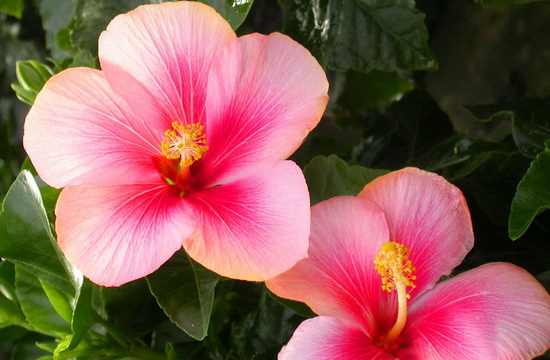
Hibiscus flowers in the photo
Hibiscus is the national plant of the Hawaiian Islands. There it is lovingly called “the flower of beautiful ladies.”
Hibiscus Chinese
Hibiscus Chinese (Hibiscus rosa-sinensis) in natural conditions is a tree or bush up to 4-5 m high with large, shiny dark green leaves and simple flowers, usually red.
The most common are the following Chinese hibiscus flowers:
“Alicante” – with simple red flowers;

“Ankara” – yellow flowers with a red core;
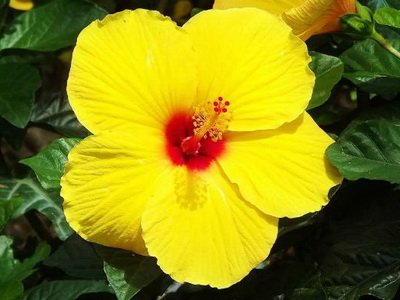
“Rosa” – with semi-double pink flowers;
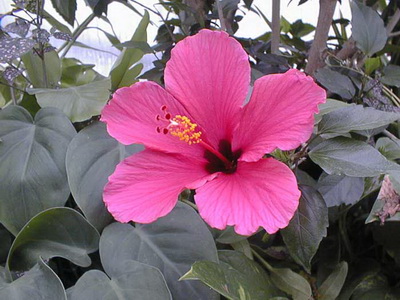
“Flamingo” is one of the most delicate varieties of domestic hibiscus. The photo clearly shows plain pink flowers with a dark core.

“Paramaribo” – flowers are simple, red;

“Rio” – pink flowers with a dark center, simple;

“Koenig” – flowers are yellow, terry;
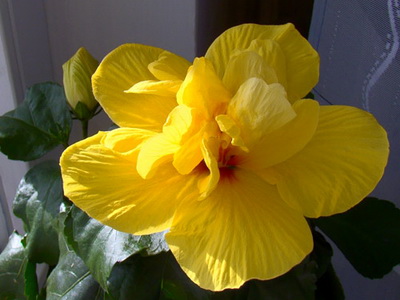
“Bangkok” – yellow flowers with a maroon center, simple;
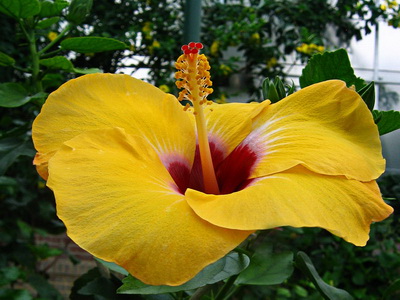
“Bari” – flowers are light yellow with a dark center, simple;
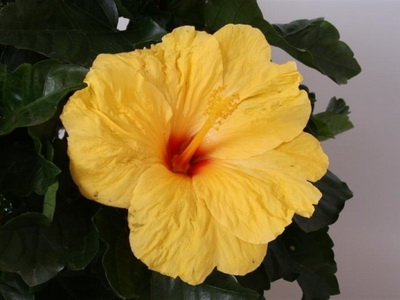
“Sunshine Purple” – rich pink flowers, simple.

Hibiscus hybrid flowers in the photo
Hybrid hibiscus, or herbaceous (Hibiscus hybrida) obtained by crossing three North American species of red hibiscus (Hibiscus coccineus), pink hibiscus (Hibiscus moscheutos) and holly hibiscus (Hibiscus militaris).

As you can see in the photo, hibiscus flowers are large, often double flowers and shiny maple-like leaves.
For the winter, the aerial part of the plant may die off.
Among the many varieties can be called such as:
“Albus” with single large white flowers;
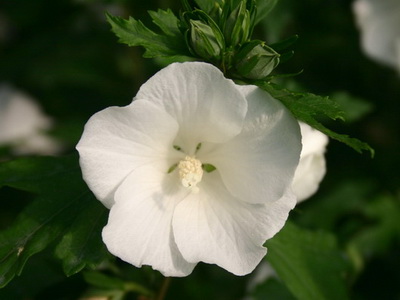
‘Coelestis’ is an upright compact shrub with short shoots and solitary violet-blue flowers;
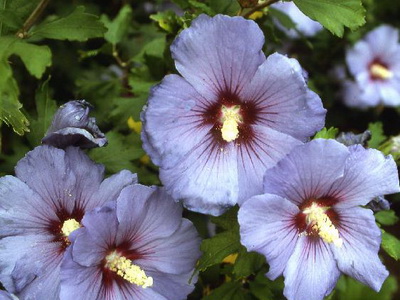
“Diana” – upright shrub with shoots up to 2 m long and numerous, very large, pure white flowers with petals wavy at the edges;
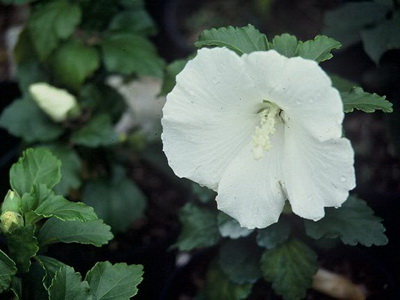
‘Hamabo’ is a tall shrub with solitary pale-pink flowers, striped on the lower half of the petals;
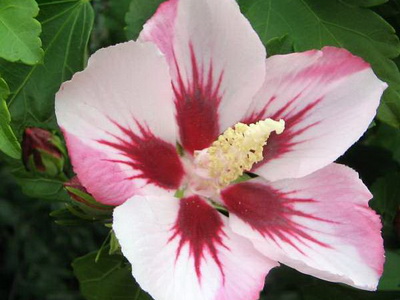
“Lady Stanley” – a low shrub with white, semi-double flowers with a pinkish tint with a dark red center;
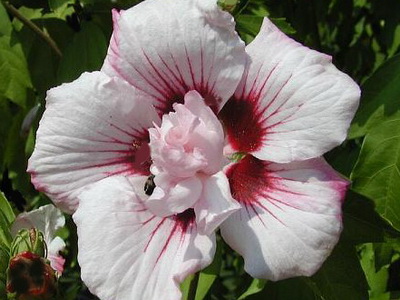
‘Pink Giant’ is an early summer variety. The photo of the hibiscus shows that this variety blooms with single pink flowers with a dark red spot at the base;

“Russian Violet” – a powerful shrub that blooms profusely with dark pink flowers;

‘Violet Elar Double’ is an upright shrub with double or semi-double violet-blue flowers that have one or more red spots on the corolla.

Hibiscus Syrian
Syrian hibiscus, or ketmia, or Syrian rose (Hibiscus syriacus) is the most difficult species to grow indoors, therefore it is much less common, mainly in winter gardens. Shrub up to 4 m tall with bright green leaves and flowers of various colors, living up to 100 years. With proper care, it blooms from mid-summer to frost with large (up to 10 cm in diameter) flowers. Depending on the variety, the flowers can be simple and double; color from white to raspberry, as well as lilac with a burgundy spot in the center of the flower. Varieties with beautiful variegated leaves have been bred, however, the flowers are less beautiful than those of other varieties.
Hibiscus care at home: lighting
Hibiscus is an unpretentious plant, but in order to fully enjoy its beauty, you need to create optimal conditions for growth. Hibiscus care at home involves bright lighting. You need to shade varietal hibiscus only from the midday summer sun. The temperature in summer is about +20 +22 ° C, in winter for abundant flowering next year a moderate cold snap (up to + 14 + 16 ° C) will be useful, but you can also leave it in a warm room.
How to care for hibiscus: watering
In summer, these plants are watered abundantly, in winter moderately. Humid air favorably affects the appearance of the plant, but spraying is undesirable, it is better to use other methods to increase humidity. How to care for hibiscus is described in numerous guides to caring for houseplants. One of the most common recommendations is to create a humid environment by wrapping the plant overnight with a damp film.
Home hibiscus flower care: top dressing
From May to the beginning of September, weekly top dressing with complex mineral fertilizer is necessary; in winter, with warm placement, it is carried out once a month. Hibiscus flower care involves pruning, which is best done in the spring. It is at this time of the year that the formed buds are best seen.
Hibiscus care in the photo: reproduction and transplantation
Hibiscus are propagated by green and semi-lignified cuttings in February, March and August. To improve root formation, it is better to use phytohormones.
As you can see in the photo, careful care of hibiscus will allow you to form a beautiful bush. Following all the recommendations, you can grow a spectacular tapeworm for a spacious hall or living room, and a small flowering plant is a wonderful holiday decoration.








